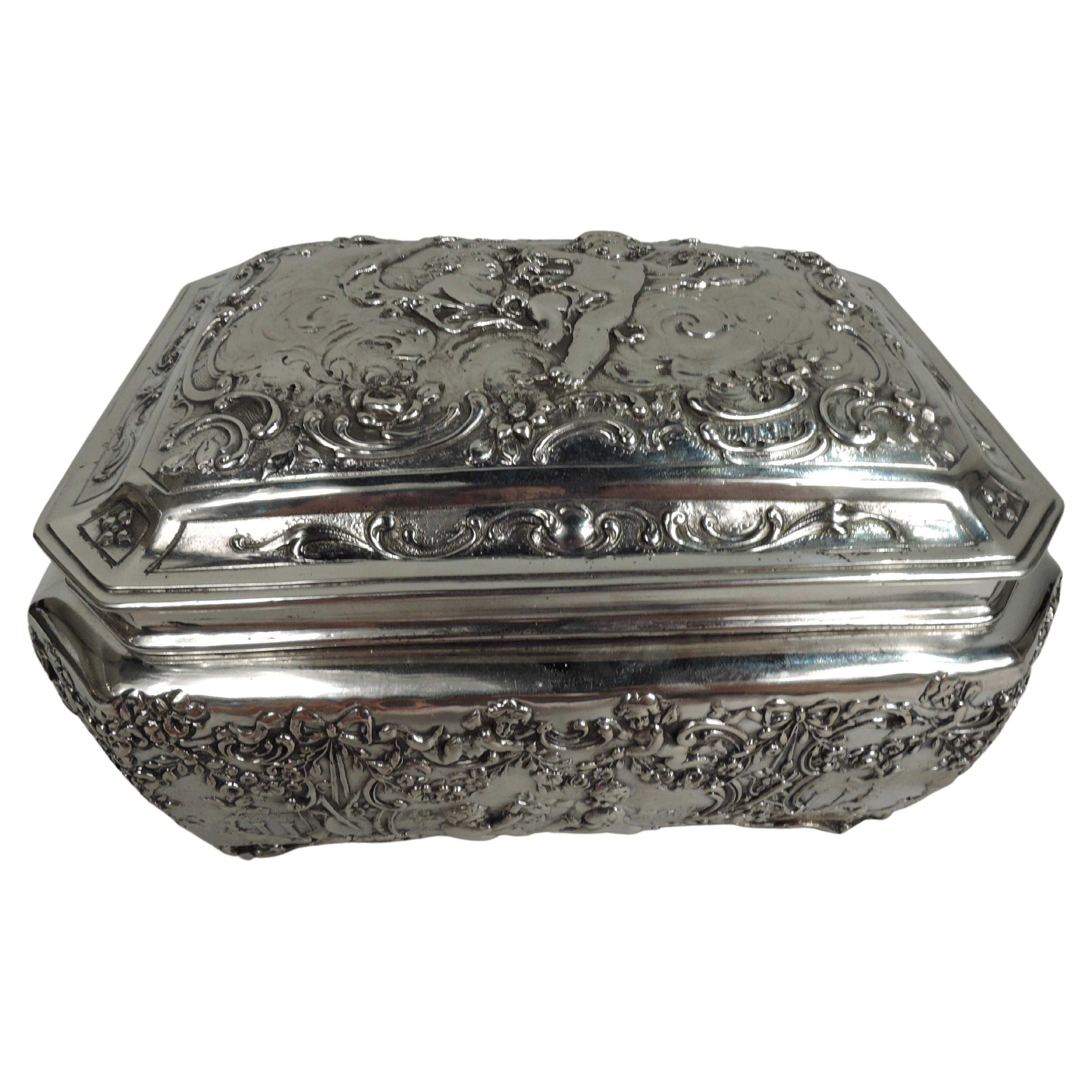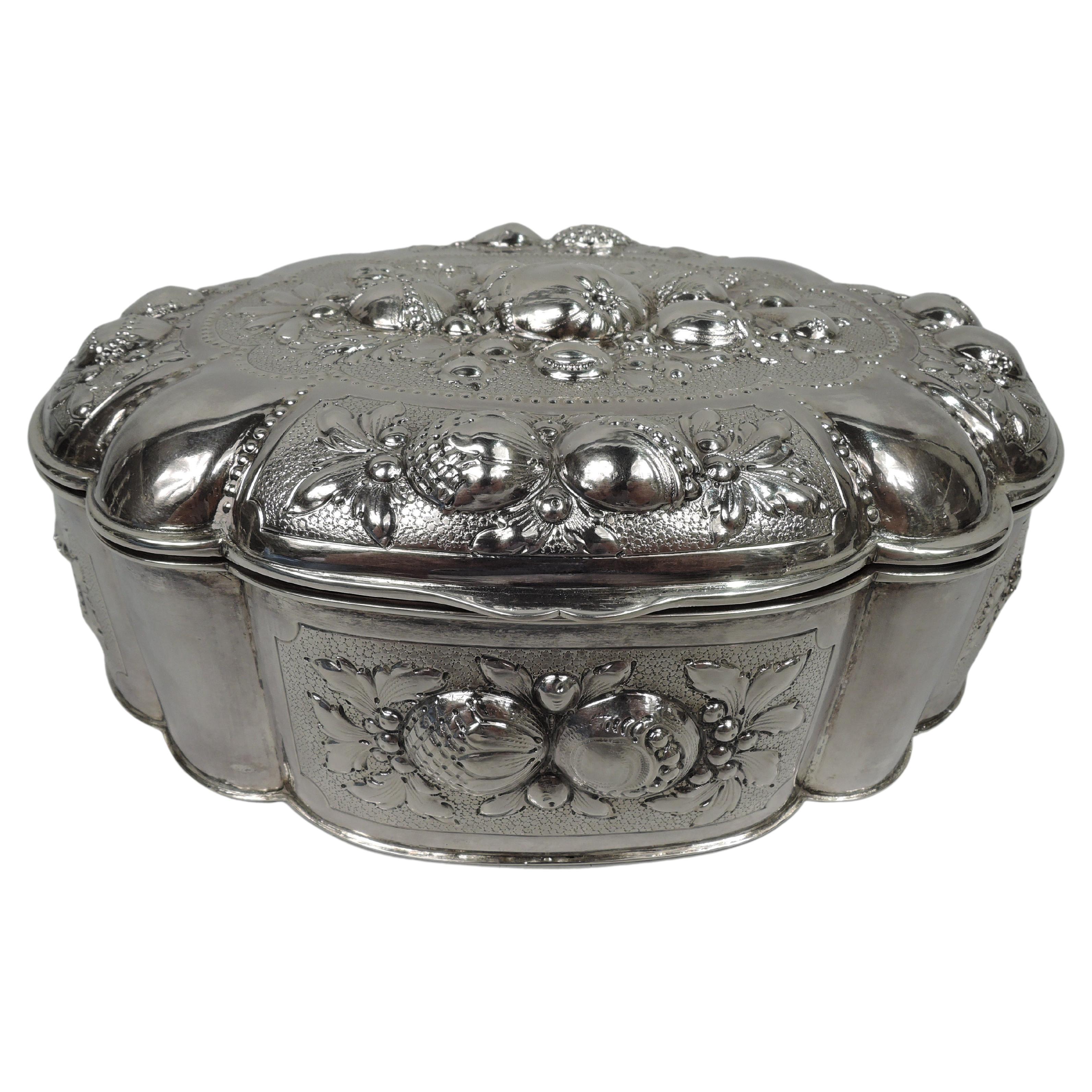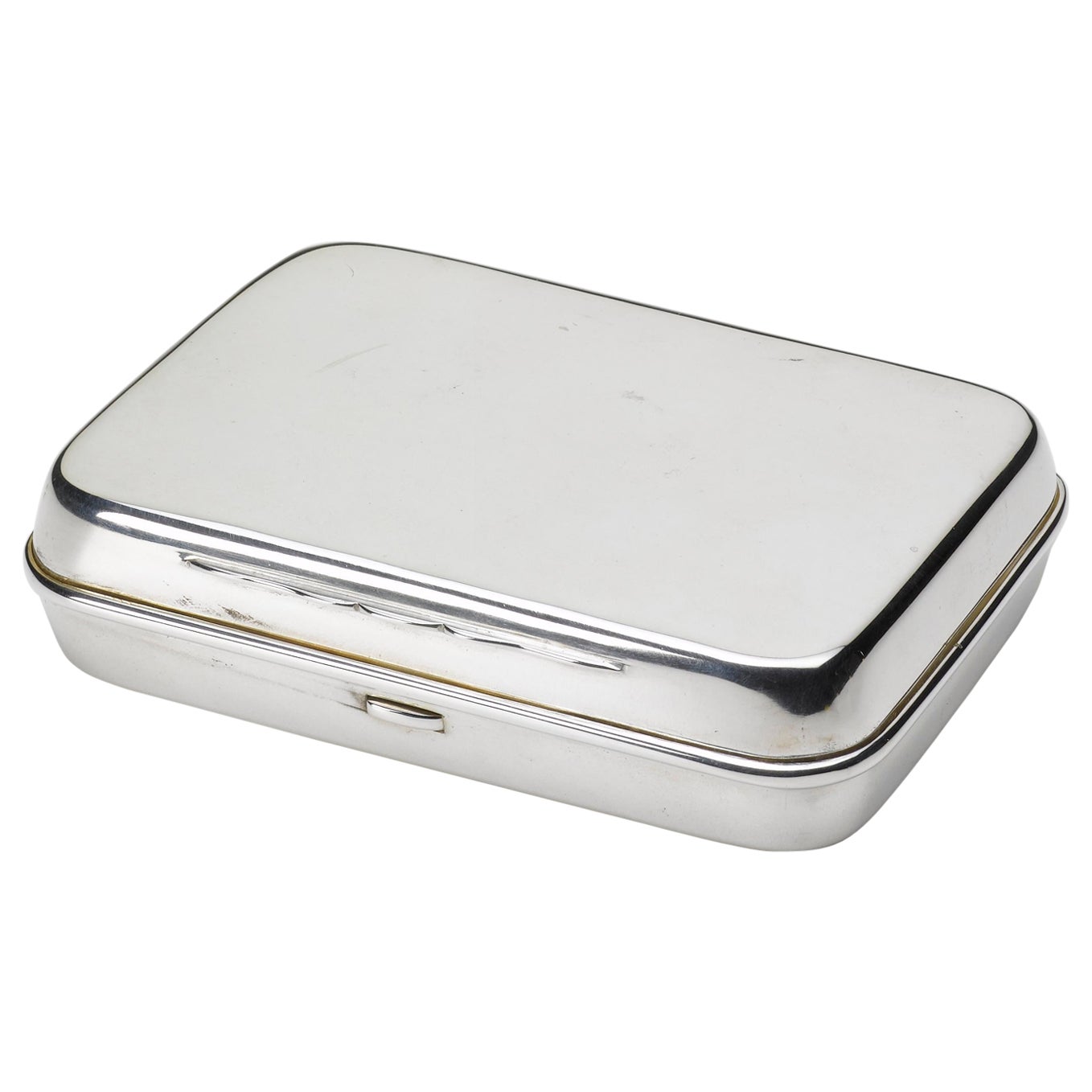Items Similar to Brass-Plated German Secessionist Keepsake Box
Want more images or videos?
Request additional images or videos from the seller
1 of 5
Brass-Plated German Secessionist Keepsake Box
About the Item
Brass-plated German secessionist keepsake box.
- Dimensions:Height: 2.5 in (6.35 cm)Width: 8.25 in (20.96 cm)Depth: 5.25 in (13.34 cm)
- Place of Origin:
- Period:
- Date of Manufacture:1910
- Condition:
- Seller Location:Los Angeles, CA
- Reference Number:1stDibs: LU93883443832

About the Seller
5.0
Vetted Seller
These experienced sellers undergo a comprehensive evaluation by our team of in-house experts.
Established in 1978
1stDibs seller since 2012
56 sales on 1stDibs
Typical response time: 1 to 2 days
- ShippingRetrieving quote...Ships From: Los Angeles, CA
- Return PolicyA return for this item may be initiated within 1 day of delivery.
More From This SellerView All
- Nickel-Plated DoorplatesLocated in Los Angeles, CAFantastic nickel-plated brass doorplates with a decorative beveled edge. Hole for a cylinder lock. Eight available.Category
Vintage 1960s American Doors and Gates
- German Glass and Chrome PendantLocated in Los Angeles, CAGerman smoked glass and chrome pendant newly rewired for one standard light bulb.Category
Vintage 1970s German Chandeliers and Pendants
MaterialsChrome
- Silver Plated French Art Deco ChandelierLocated in Los Angeles, CAGorgeous French, deco chandelier with nickel candle covers. Newly rewired for six standard bulbs.Category
Vintage 1930s French Art Deco Chandeliers and Pendants
- Pair of Silver Plate Curtain TiebacksLocated in Los Angeles, CAIntricate oversized silver plate curtain tiebacks.Category
Antique 1870s American Wall Brackets
MaterialsSilver Plate
- Brass PendantLocated in Los Angeles, CAAmerican brass fixture with enameled details; newly wired for a standard bulb.Category
Vintage 1930s American Chandeliers and Pendants
MaterialsBrass
- Pair of 1930s Acid-Etched Push PlatesLocated in Los Angeles, CAPair of 1930s acid-etched mirror push plates with flower and bird detailing; original decorative screws included. Originally used on swinging doors between...Category
Vintage 1930s Architectural Elements
MaterialsGlass
You May Also Like
- Antique German Rococo Silver Keepsake Casket BoxLocated in New York, NYTurn-of-the-century German Rococo 800 silver box. Rectilinear with tapering sides and chamfered corners with scroll supports. Cover hinged, raised, and ...Category
Antique Late 19th Century German Rococo Revival Sterling Silver
MaterialsSilver
- Antique German Silver Fruits and Foliage Keepsake BoxLocated in New York, NYGerman 800 silver box, ca 1910. Oval and lobed. Cover hinged and raised with scroll tab. Sides have chased and engraved fruits and foliage on stippled g...Category
Early 20th Century German Victorian Sterling Silver
MaterialsSilver
- Diminutive Viennese Secessionist Brass & Velvet BoxLocated in West Palm Beach, FLDiminutive Viennese Secessionist Brass & Velvet Box Austria, Circa 1920s A highly detailed and distinctive Diminutive Viennese Secessionist brass & velvet box, originating from Aust...Category
Early 20th Century Austrian Vienna Secession Decorative Boxes
MaterialsBrass
- Silver Plated Keepsake Box, Early 20th CenturyLocated in Colorado Springs, COOffered is a silver plated keepsake box, dating to the early 1900s. The hallmarked box offers great storage solution for jewelry, cufflinks, and other keepsakes, with a divided inter...Category
Antique Early 1900s English Jewelry Boxes
MaterialsSilver
- Hallmarked Silver Plated Keepsake Box, Sheffield, Uk, Circa 1900Located in Colorado Springs, COOffered is a stunning Sheffield silver keepsake box dating to 1900, with associated hallmark. This small box includes a clean interior and rounded corners. The box is free of names or initials, but would have been used to house keepsakes such as jewelry or cufflinks. A well maintained, elegant piece, this antique silver box is an excellent addition to any silver collection. Trinket or keepsake boxes have taken on many forms since their first conception in ancient times. However their purpose remains the same; to store jewelry and other items precious to the owner. Originally, these boxes were used specifically for jewelry. These were in common use as early as 5000 BC in Ancient Egypt, when the majority of Egyptians, both male and female, wore jewelry. Boxes were used to keep these gemstone encrusted items safe. In Ancient Rome, jewelry was a status symbol. Rings and brooches were utilized to represent ones status in society. Again, boxes were needed for security and storage purposes. Finding early examples of these are quite rare. Victorian and Edwardian examples of trinket boxes are far more common. This is because owning jewellery was a luxury until the Victorian era- let alone possessing so much a box was needed to store it all. Fine jewelry and other items became available to the masses after the industrial revolution due to the reduction in production costs. This led to a demand for trinket boxes, which were much smaller than jewelry boxes and therefore better suited to the needs of the middle class who did not yet possess an abundance of jewelry. In Victorian households, collectables and other items of interested were also stashed inside these boxes. This is why they are known as trinket or keepsake boxes, rather than just jewelry boxes, although of course jewelry was also stored in them. Trinket boxes were produced in large numbers around this time. Many were lined with colored plush or velvet or rich wood. More elaborate designs had interior divisions and trays for rings and other pieces of jewellery. It was also common to see trinket boxes so small that they could only contain one item, such as a single ring. Ornate exteriors were created to reflect the value of the trinket boxes contents. The Edwardian era saw the introduction of new styles of trinket box. These included small circular or oblong boxes...Category
Antique Early 1900s British Art Deco Decorative Boxes
MaterialsSilver
- Hallmarked Silver Plated Keepsake Box, Sheffield, UK, circa 1900Located in Colorado Springs, COOffered is a stunning silver plated keepsake box dating to 1900, with associated hallmark. This small box includes a wooden interior with two slots and a blank square on top where initials could have been engraved. A well maintained, elegant piece, this antique silver box is an excellent addition to any silver or home decor collection. Trinket or keepsake boxes have taken on many forms since their first conception in ancient times. However their purpose remains the same; to store jewelry and other items precious to the owner. Originally, these boxes were used specifically for jewelry. These were in common use as early as 5000 BC in Ancient Egypt, when the majority of Egyptians, both male and female, wore jewelry. Boxes were used to keep these gemstone encrusted items safe. In Ancient Rome, jewelry was a status symbol. Rings and brooches were utilized to represent ones status in society. Again, boxes were needed for security and storage purposes. Finding early examples of these are quite rare. Victorian and Edwardian examples of trinket boxes are far more common. This is because owning jewellery was a luxury until the Victorian era- let alone possessing so much a box was needed to store it all. Fine jewelry and other items became available to the masses after the industrial revolution due to the reduction in production costs. This led to a demand for trinket boxes, which were much smaller than jewelry boxes and therefore better suited to the needs of the middle class who did not yet possess an abundance of jewelry. In Victorian households, collectables and other items of interested were also stashed inside these boxes. This is why they are known as trinket or keepsake boxes, rather than just jewelry boxes, although of course jewelry was also stored in them. Trinket boxes were produced in large numbers around this time. Many were lined with colored plush or velvet or rich wood. More elaborate designs had interior divisions and trays for rings and other pieces of jewellery. It was also common to see trinket boxes so small that they could only contain one item, such as a single ring. Ornate exteriors were created to reflect the value of the trinket boxes contents. The Edwardian era saw the introduction of new styles of trinket box. These included small circular or oblong boxes...Category
Antique Early 1900s English Art Deco Decorative Boxes
MaterialsSilver
Recently Viewed
View AllMore Ways To Browse
Antique English Wood Boxes
Limoge Box
English Antique Wood Boxes
Leather Rectangular Box
Chinese Lidded Box
Hand Painted Chinese Box
Dragon Box
Copper Hinges
Pearl Inlay Box
Chinese Hand Painted Boxes
Key Pin
Box Cube
Antique Indian Brass India
Vintage Decorative Storage Boxes
Decorative Vintage Storage Boxes
Antique Book Box
Antique Book Boxes
Circle Box





